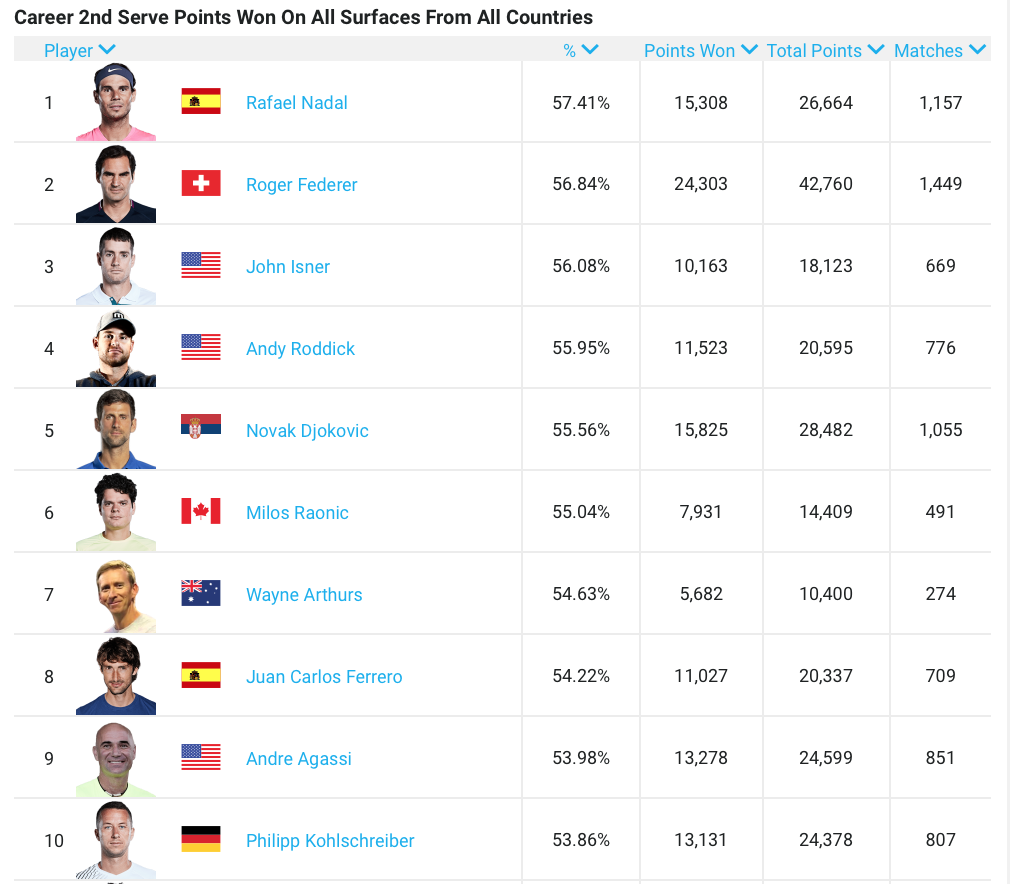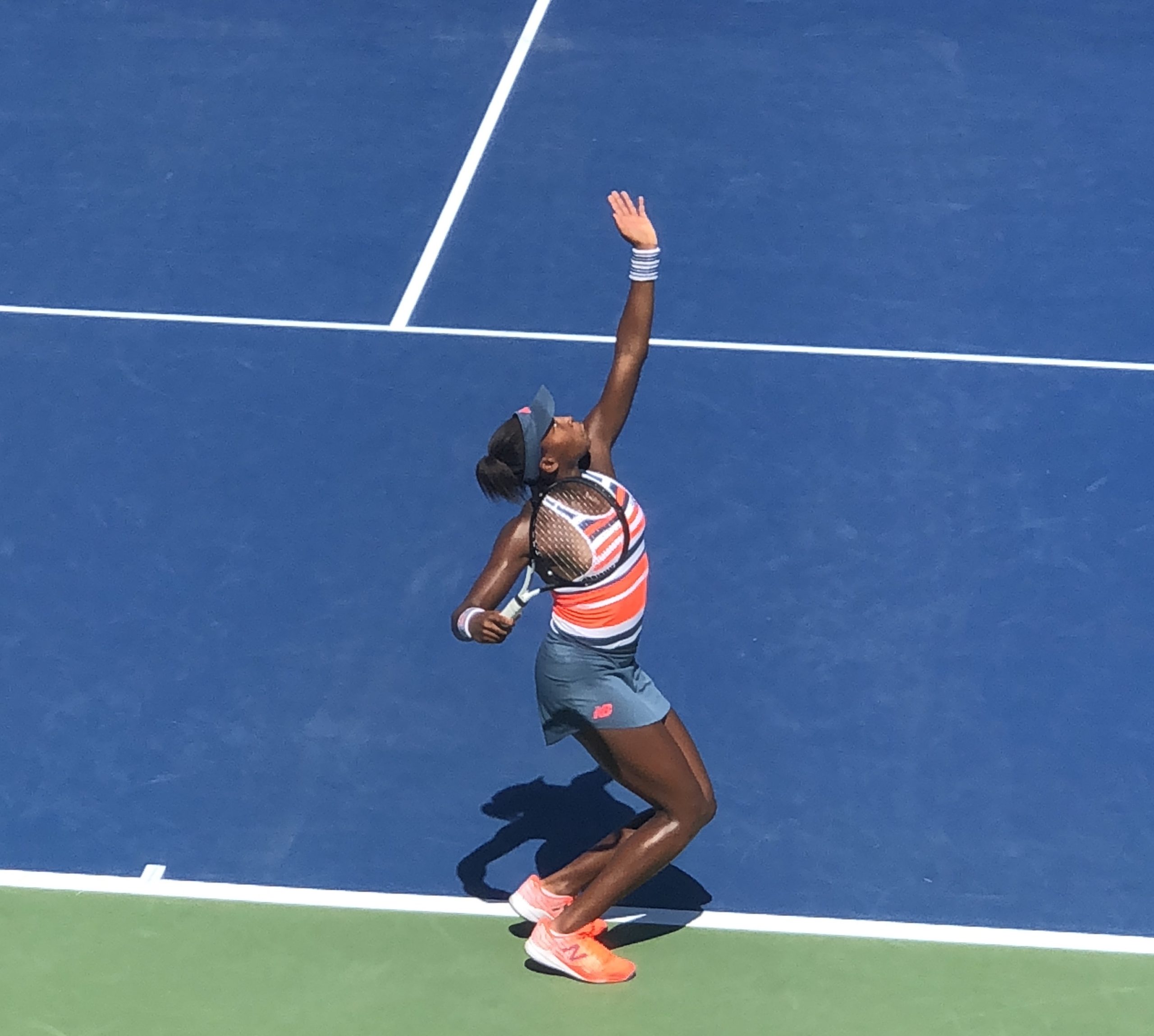When Do 2nd Serves Become An Asset?
In the past THIRTY YEARS, only 160 players on the ATP World Tour have forged a WINNING percentage (above 50%) behind their second serve. That’s only about five players each year getting added to this reputable list. Just five.
The ceiling on this list stops short of 60%. Here’s the best of the best…


So now we know the ceiling on the pro tour. What about the rest of us? How good is the performance of our 2nd serves?
That’s the secret sauce of GAMEPLAN, the Player Development Pathway course on this website. I want to give you a sneak peek as to what’s under the hood of GAMEPLAN. Second serve points won provides a perfect snapshot!
Question for you.
At what level do 2nd serves move from being a liability to an asset – for both male and female players?
In other words. at what level does the average win percentage migrate above 50%?
GAMEPLAN focuses on 10 levels along the Player Development pathway, starting with Under 12, and finishing with the Top 10 in the world.
NOW FOR THE ANSWER!
Let’s start with male players first, and uncover exactly where the line in the sand is when 2nd second serves finally become an asset – winning more than 50% of points.
MALE PLAYERS
| Level: MALE | Win Percentage | Is It An Asset? |
|---|---|---|
| U12 | 43% | NO |
| U14 | 44% | NO |
| U16 | 46% | NO |
| U18 | 47% | NO |
| College: Levels 5&6 | 47% | NO |
| College: Levels 3&4 | 48% | NO |
| College: Levels 1&2 | 49% | NO |
| Challenger | 50% | EVEN |
| Top 100 | 52% | YES |
| Top 10 | 53% | YES |
It’s not until tennis becomes your full-time job and you begin to excel at it that 2nd serves move from the liability to the asset column.
- 2020 Australian Open Men = 50.8% (5154/10,147)
An important element to consider here is the practice court. Think for a moment how juniors around the world have their time organized in their practice sessions.
Keep it simple – how much time is specifically spent developing forehands and backhands, and how much time is specifically dedicated to developing second serves? It feels like a 99% to 1% ratio! Second serves are so important in a match but are barely an afterthought on the practice court.
What can you focus on with second serves?
Well, firstly there is the motion of the serve. The toss is also a key component. Then there is mastering the variety of spins, and the depth in the service box.
You can work on hitting targets and you can definitely work on improving with the defensive Serve +1 groundstroke that you are probably going to get smacked right back at you by the returner. A lot of 2nd serve points are lost right there. The second serve goes in, but the server is crunched for time on their very next shot and dumps a forehand or backhand straight in the net because they can’t get their hands and feet correctly organized quickly enough.
Imagine, for just a moment, if ALL of those elements of the 2nd serve were consistently worked on. A little bit every. single. day.
Would we still have losing percentages all through the junior and collegiate levels? I doubt it!
Now let’s take a lot at the female players. When do second serves become an asset?
FEMALE PLAYERS
| Level: FEMALE | Win Percentage | Is It An Asset? |
|---|---|---|
| U12 | 41% | NO |
| U14 | 41% | NO |
| U16 | 43% | NO |
| U18 | 43% | NO |
| College: Levels 5&6 | 42% | NO |
| College: Levels 3&4 | 43% | NO |
| College: Levels 1&2 | 43% | NO |
| Challenger | 46% | NO |
| Top 100 | 47% | NO |
| Top 10 | 47% | NO |
Here are three examples…
2015 Wimbledon Final: Serena Williams def. Garbine Muguruza 6-4, 6-4
Combined 2nd Serve Performance for both ladies: 17/49 = 35%
2014 Wimbledon Final: Petra Kvitova def. Eugenie Bouchard 6-3, 6-0
Combined 2nd Serve Performance for both ladies: 13/35 = 37%
2017 Australian Open Tournament Total= 46% (3277/7109)
2020 Australian Open Tournament Total = 46% (2968/6476)
The very essence of GAMEPLAN is to uncover areas in our game that are greatly underperforming because… our practice court is BROKEN!
If you play tennis just for fun and enjoy the social elements, the fitness, and meeting new friends, then don’t really worry about working on your 2nd serve. It’s all good!
But…
If you compete. If winning matters. If tennis is your thing. If tennis drives you and soaks up hours of your life every single day, then you better change how you practice. You better start setting specific time aside to work on the many elements of the 2nd serve – to move it from the liability column to the asset column.
Big data has finally arrived for the Player Development pathway. Welcome to GamePlan!
Cheers,
Craig


